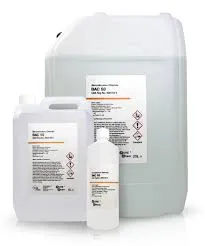flocculant vs coagulant
Flocculants vs. Coagulants Understanding the Differences and Applications
When it comes to water treatment, both flocculants and coagulants play crucial roles in ensuring that water is purified and safe for use. Although the terms are often used interchangeably, they refer to different processes and substances. Understanding these differences can help in selecting the appropriate treatment method for specific water quality issues.
What are Coagulants?
Coagulants are chemical agents that promote the aggregation of suspended particles in water. When added to water, coagulants neutralize the charges that keep these particles separated. This neutralization allows the particles to come together to form larger clusters or flocs. Common coagulants include aluminum sulfate (alum), ferric chloride, and polyaluminum chloride. These substances work best in a controlled environment where the pH and temperature are optimal for their function.
Coagulation is typically the first step in the water purification process, particularly in drinking water treatment and wastewater management. It is essential for removing turbidity, color, and other impurities from water. Without this initial phase, finer particles would remain suspended, making it difficult for subsequent processes to function effectively.
What are Flocculants?
Flocculants, on the other hand, are used after coagulation to enhance the process of particle agglomeration. They are usually high molecular weight polymers that further stabilize and promote the growth of flocs formed during the coagulation phase. Flocculants facilitate the connection between particles, allowing them to clump together into even larger, more manageable aggregates. This makes the removal of these particles easier and more efficient.
Common flocculants include polyacrylamide and natural polysaccharides like guar gum
. The use of flocculants is particularly important in sludge thickening, clarification, and filtration processes.The Differences Between Coagulants and Flocculants
flocculant vs coagulant

1. Function The primary function of coagulants is to destabilize and aggregate fine suspended particles, while flocculants’ role is to enhance the formation of larger aggregates, thereby improving the removal process.
2. Chemical Nature Coagulants are typically inorganic salts or metals, whereas flocculants are often synthetic or natural polymers. This difference in chemical composition also influences their mode of action in the water treatment process.
3. Application Sequence Coagulants are used first in the treatment process to create smaller flocs, and flocculants are subsequently added to promote the formation of larger, easier-to-remove flocs.
4. Performance Characteristics The performance of coagulants is often affected by water pH and ionic strength, while flocculants are generally more effective across a wider range of conditions but require careful control of dosing to avoid over-flocculation, which can lead to inefficiency.
Applications in Water Treatment
The combination of coagulants and flocculants is widely applied in various water treatment processes. In municipal water treatment plants, coagulants are used to treat raw water, followed by the addition of flocculants to enhance the sedimentation process in clarifiers. In wastewater treatment, similar techniques are employed to remove contaminants effectively, while industries such as paper manufacturing, mining, and food processing also rely on these agents for various separation processes.
Conclusion
In summary, while flocculants and coagulants are integral to the effective treatment of water, they serve distinct roles in the process. Coagulants stabilize suspended particles, allowing them to aggregate, while flocculants promote further agglomeration into larger particles for easier removal. Understanding these differences is essential for water treatment professionals to optimize processes, ensure compliance with water quality standards, and safeguard public health. A well-designed water treatment process harnesses the strengths of both coagulants and flocculants, ensuring that water is not only safe for consumption but also contributes to sustainable environmental practices.
-
Water Treatment with Flocculant Water TreatmentNewsJun.12,2025
-
Polymaleic AnhydrideNewsJun.12,2025
-
Polyaspartic AcidNewsJun.12,2025
-
Enhance Industrial Processes with IsothiazolinonesNewsJun.12,2025
-
Enhance Industrial Processes with PBTCA SolutionsNewsJun.12,2025
-
Dodecyldimethylbenzylammonium Chloride SolutionsNewsJun.12,2025





